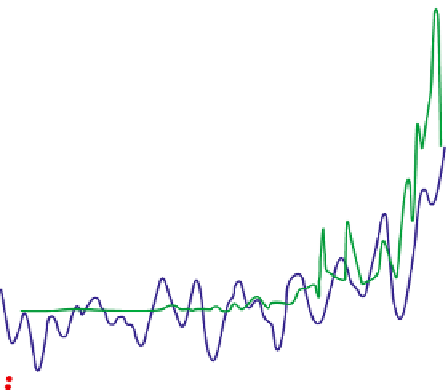Geoscience Reference
In-Depth Information
Cyclotella pseudostelligera
October mean temperature
12
9
6
3
3
0
0
-3
1800
1850
1900
Year
1950
2000
Figure 2.6
Percentage
Cyclotella pseudostelligera
vs October temperature for Lake
Redo, Pyrenees. (From Catalan
et al
. 2002.)
Whilst adopting the approach of Wolfe
et al
. (2001) can help to reduce uncertainty
by identifying sites with a history of N deposition, a more definitive approach is
to seek analytical evidence for climate warming that is not dependent on nutrients
but on other impacts of global warming, such as reduced ice cover. An example is
the work of Douglas
et al
. (1994) from Ellesmere Island in the high Canadian
arctic. In this case, the diatom changes in the uppermost sediments were ascribed
to a reduction in the length of summer ice cover, leading to the creation of a more
extensive littoral habitat with an increase in aquatic bryophytes providing a habitat
for diatom epiphytes such as
Pinnularia balfouriana
(Fig. 2.7).
Separating climate change from pollution impacts at polluted sites
In populated regions of the world where most, if not all, lakes are suffering or
recovering from the severe impacts of human activity, identifying the influence of
climate change is more problematic, mainly because climate change is yet to
become a dominant driving force and the effects of climate change are as yet
masked by pollutant effects (e.g. Anderson
et al
. 1996). Attempts to address this
issue, especially with respect to problems of acidification and eutrophication,
have focussed both on the analysis of long-term observational data sets (e.g.
Straile 2000; Jepessen
et al
. 2005; George
et al
. 2007; Ferguson
et al
. 2008) and
on the palaeolimnological record.

























































































































































































Search WWH ::

Custom Search